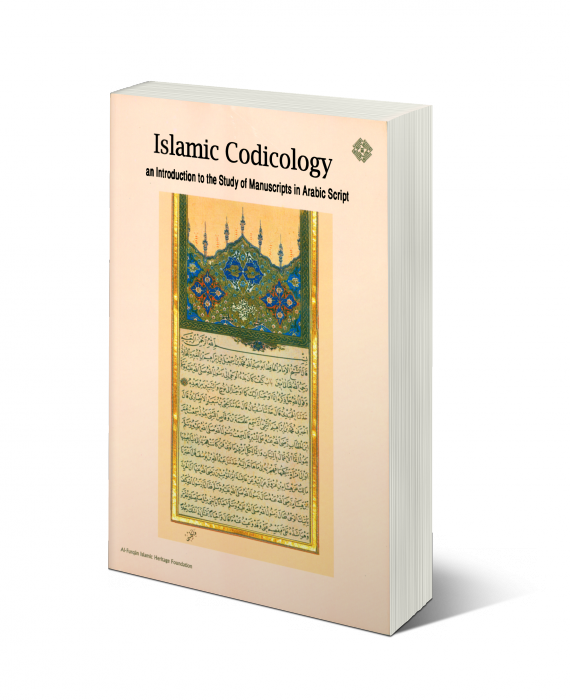
Editor: Mohamed Isa Waley
Publisher: Al-Furqan Islamic Heritage Foundation
Year: 2006
Source: https://www.al-furqan.com/our_publications_item/bookid/100895
A culture of learning
This is a collection of unique essays on the art and science of book production in the period when manuscripts were copied by hand – the age of the ‘handwritten book’. It is concerned with issues such as the types of materials used – the paper, pen, ink, glue, pigment, binding – and also the scribes or copyists who worked from an author’s manuscript to produce books for the mass market. Codicology “sheds light on the history of the period in which a book was produced”, and can be of no less import than the history books of the period itself.
Prior to 8th Century, the main medium for the written word was the scroll, tied to the liturgical use by Jewish communities. The advent of Islam had a unique equalizing effect on society because the Qur’an was accessible to all. The first Qur’ans and Ummayad administrative records were on parchment with the individual sheets bound together. The parchment materials were either reed-type plant (botanical name Cyperus papyrus L.) or animal skin (parchment). Papyrus was relatively expensive. Hence “every single part of a sheet of papyrus has sometimes been gradually encroached upon by writing until it is eventually covered with script in every direction”.
The breakthrough came with the introduction of paper, linked to know-how obtained from the Chinese after Ummayad forces defeated a T’ang army in Talas (northwestern Kyrgyzstan) in 751. The new technology was rapidly absorbed, and al-Biruni, visiting Samarkand in 794 described the use of a hydraulic power hammer in one of the paper mills. Baghdad, the Abbasid capital, had its own paper mill by 794. The paper trade grew rapidly, “and the custom arose of calling the various grades of produce by the names of the cities in or near which mills were set up (Baghdadi, Samarqandi and so on), water quality being a notable influence on that of the paper produced. Paper from Baghdad, for example, enjoyed a reputation for fineness until the ninth/fifteenth century, though the adjective ‘Baghdadi’ also simply designated a sheet of paper of large size”.
Not surprisingly, the main tool of trade, the pen and ink, was focus of much research and development, “some scribes and copyists kept their methods of cutting reeds a secret, al-Dahhak hiding while he performed the operation, while a certain al-Ansari snapped off the tips of his reeds after use”. There was also an interaction between ‘the tools of production’ and the output, an early example of value-laded technology! For example, the ways pens were cut in the Maghrib – “with a flat and bevel trimmed tip” – allowed for greater individuality because the edges of letters could be blurred. The Maghribi stroke was akin to painting, while Naskhi strokes with crisp, clear edges conveyed a “virile appearance”.
There were numerous treatises on ink production and advances in botany and chemistry were closely tied with the social needs of the day. The treatises of the thirteenth century include discussions on the suitability of inks for different types of paper and also the means of erasing ink from fabrics. The poet Al-Mawardi’s description of ink as “the perfume of men” illustrates the culture of learning in that period of Muslim history. The great calligrapher of Ibn al-Bawwab (died 1022) even incorporated his ink recipe in a qasida.
The Fatimid ruler al-Muizz had his craftsman design for him a fountain pen in gold, in which “after adjustments, the ink released by the reservoir flowed evenly down to the nib and the instrument might be turned in any direction without the ink leaking”.
‘Islamic Codicology’ comes to life in its accounts of the lives and practices of the copyists and their employers. In one suburb of Cordoba alone “one hundred and seventy women were occupied transcribing Qur’ans in Kufic characters”. A Persian traveler in the mid-sixteenth century describes book production organised in family-based workshops in Shiraz: “in every house in this city the wife is a copyist, the husband is a miniaturist, the daughter an illuminator, and the son a binder. Thus any kind of book can be produced within one family”.
The copyists were employed by a ‘warraq’ – the first generation publishers. Other patrons and supporters were the sultans, libraries, madrassas, zawiyyas, mosques and religious foundations. Moreover, “the sheer speed of executing Arabic script was a source of amazement to observers”. In many cases, all that we know of the copyists are the clues provided by their ‘colophon’ or characteristic trademark left on a hand-written book. The copyist Ali ibn Muhammad, declares in his colophon that he took a fortnight to copy two hundred and seventy-three leaves the Mathnawi of Jalal al-Din Rumi. Endearingly many copyists leave a message seeking forgiveness of the reader for any errors.
This is a book packed with fascinating detail and a delight for book-lovers because it brings together in a single volume a variety of disciplines and domains of expertise. There are eight separate contributors to this work, but in the best traditions of copyists sharing work on a manuscript, it is difficult to relate their specific contributions to chapters. The editor is to be commended for his effort in ensuring coherence. The presence of proof-reading errors is ironical given the subject matter, but these do not detract in the least from an otherwise informative work of scholarship.
M A Sherif
”.
